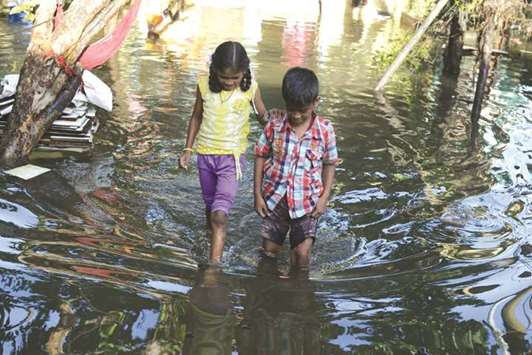The western state of Gujarat will move 15 villages that were affected by floods this year to higher ground, officials said, as they look for new ways to tackle the increasing frequency and intensity of flooding.
Villages in northern Banaskantha and Patan districts will be moved within a 10km radius of their existing locations after consultation with residents, state Deputy Chief Minister Nitin Patel told reporters.
“These villages are in low-lying areas and were affected by similar floods in 2015. They will now be moved to higher ground in a nearby location,” he said.
The state will offer financial support to rebuild homes and also build schools and other facilities, he added.
The relocation will be modelled after a similar move following a massive earthquake in 2001 that levelled several villages in the state and killed thousands, Patel said.
Dinesh Mishra from the non-government organisation Barh Mukti Abhiyan, which works with communities in flood-prone areas, said officials in Gujarat must not coerce people into moving, and need to ensure residents are given adequate compensation for any losses suffered due to the move.
“Relocation may be a solution in Gujarat, where there is land, but what about other states where there is nowhere to go?,” he said.
“People have deep ties to where they live; you cannot move everyone affected by floods to higher ground.”
Heavy monsoon rains in South Asia this year triggered the worst floods in a decade in India, Nepal and Bangladesh, killing hundreds of people and affecting tens of millions.
India has the most exposure to damage from river flooding, according to research organisation World Resources Institute.
While monsoon rains trigger floods in northern and eastern India every year, Gujarat which is in a semi-arid region, has also experienced floods more frequently in recent years as warming temperatures bring heavier rains.
Analysts have criticised the government’s flood mitigation measures, including massive embankments and river linking schemes they say will only exacerbate the damage.
An official audit of India’s flood management schemes over the last decade found they lacked forecasting mechanisms, preemptive safety measures and effective post-flood management.
Experts said urban floods are entirely man-made with poorly maintained drains, plastic bags, shrinking open spaces and climate change contributing to accumulation of water on roads after a heavy downpour.
They said that steps such as rainwater harvesting, ban on use of plastic bags and better use of weather forecasts will go a long way in helping tackle flooding in cities after rains.
V K Sharma, Senior Professor of Disaster Management at the Indian Institute of Public Administration (IIPA), said cities need a proper system of garbage collection and sewage disposal and regular cleaning of drains.
“It is true that poor drainage and sewage system is the real cause of urban flooding. There is also migration to cities which often leads to land encroachment and exerts pressure on the existing civic infrastructure,” Sharma said.
Sharma said the urban planning has to have a long-term perspective and infrastructure should keep pace with growth of population.
He said rain water harvesting should be made mandatory.
“There is also the need of fixing accountability of government officials and municipal authorities if drains are not properly cleaned. Strict penalties should be imposed on people throwing garbage in the open.”
He said steps have been taken at some places to ban use of plastic bag but it should be enforced strictly.
“There is need to make people aware. This will also meet the larger goal of cleanliness.”
Santosh Kumar, a professor at the National Institute of Disaster Management with expertise in disaster risk reduction and policy planning, said climate change was also a factor in cities getting excessive rainfall.
“Urban flooding occurs when water flows into an urban region faster than it can be absorbed into the soil. Earlier, a city received such amount of rainfall in two to three weeks,” Kumar said, referring to Mumbai getting 350mm rainfall on August 29-30.
Meanwhile, a downpour in Bengaluru disrupted life for several hours and a portion of a campus wall of software major Infosys collapsed in early yesterday, an official said.
The local Met Office said the southern city received a record 70mm rainfall that was accompanied by squally winds in the last 12 hours.
Low-lying areas were inundated and trees and electricity poles were uprooted in many places.

Two children wade through a flooded street after rains lashed Bengaluru yesterday.
